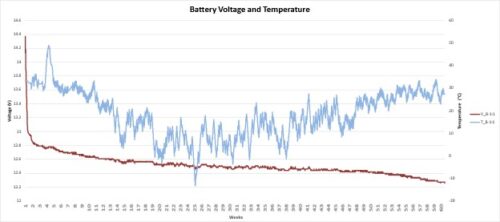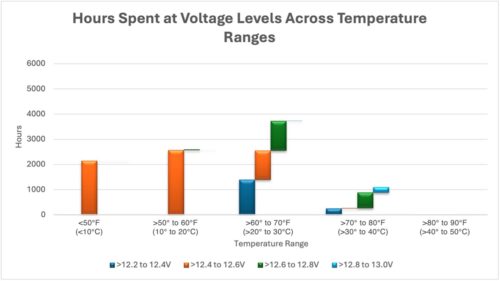EnerSys conducted a study evaluating the self-discharge and environmental exposure of ODYSSEY® Connect-enabled batteries stored in uncontrolled temperature conditions. The analysis focused on voltage behavior, time spent in specific voltage ranges and the impact of extreme temperature deltas on storage performance. The batteries were stored in an unconditioned outdoor storage container located in Climate Zone 4 of the Southeastern region of the United States. The storage period lasted 400 days. During this time, the study began with a charged Group 31 battery, which was exposed to harsh seasonal weather conditions.
ODYSSEY® Connect-enabled batteries feature a patented technology that allows end-users to actively monitor the battery’s State of Charge (SOC), State of Health (SOH), voltage and temperature. Users can view warnings and safety notifications via Bluetooth® on their Apple® or Androidä smart device, and can also review battery trends to spot performance anomalies.
Methodology
During the study, time-series data for voltage and temperature were collected from an integrated monitoring chip located inside the ODYSSEY® Connect-enabled battery. The chip recorded real-time operational data throughout the storage period. A summarized dataset detailing the time spent in specific voltage (<13V) and temperature ranges during the storage period was also obtained.
Several different metrics were examined including:
- Temperature extremes – Identification of the highest and lowest temperatures experienced by the battery and its corresponding voltage levels.
- Voltage ranges – Analysis of the hours spent in critical voltage bands, such as 13V–12.2V, to evaluate self-discharge behavior.
- Anomalies – Investigation of the impact of extreme environmental conditions (e.g., high heat or freezing temperatures) on battery voltage performance and stability.
Results
Environmental Conditions
- Temperature Summary:
- Maximum Temperature: 120.02°F (48.9°C)
- Minimum Temperature: 8.06°F (-13.3°C)
- Mean Temperature: 64.75°F (18.20°C)
- Mean Temperature Above 77°F (25°C): 86.11°F (30.06°C)
- Mean Temperature Below 77°F (25°C): 55.25°F (12.92°C)
- Voltage During Extremes:
- Voltage remained stable, ranging from 12.99V to 12.27V, indicating resilience to long-term exposure to extreme varying conditions.
Time in Voltage Ranges
The time spent in various voltage bands highlights the battery’s self-discharge characteristics.
| Voltage Range (V) | Hours Spent | Percentage |
| 12.2V – 12.4V | 1,661 | 17.31% |
| 12.4V – 12.6V | 5,881 | 61.26% |
| 12.6V – 12.8V | 1,831 | 19.06% |
| 12.8V – 13.0V | 227 | 2.37% |
Key Observations: Impact of Temperature Extremes
Despite exposure to high and low extreme temperatures, the battery’s voltage did not drop below 12.2V, demonstrating robustness under long-term environmental stress in storage. Furthermore, most of the operational time occurred between 12.2V and 12.6V, reflecting moderate discharge levels. As temperature increased, the acceleration of voltage decay also accelerated.
While voltage remained stable during extreme conditions, consistent exposure to temperatures above 77°F (25°C) exacerbated self-discharge rates and reduced capacity over time
Higher temperatures may temporarily stabilize or increase voltage, but this comes at the cost of accelerated aging and reduced overall storage time. Conversely, lower temperatures tend to slow chemical reactions, preserving the battery’s lifespan but at the expense of reduced capacity. Additionally, continued exposure to uncontrolled conditions will accelerate self-discharge, causing the battery to drop below 12.2V faster, necessitating more frequent recharges.

Caption for visual: Chart above illustrates trends and fluctuations in voltage and temperature.

Caption for visual: Chart above highlights the operational focus in various discharge ranges.
Conclusion
Through this battery storage analysis, EnerSys was able to determine the following four factors:
- Storage Environment – As a best practice, batteries should be stored in controlled environments at 77°F (25°C) to mitigate the impact of extreme temperatures.
- Periodic Maintenance – Regular recharging helps maintain performance and reduces the time spent in discharged states.
- Impact of High Temperatures – During the summers of 2022 and 2023, high temperatures significantly increased self-discharge rates as observed in the chart above.
- Predicted Longevity – In a stable 77°F (25°C) environment, the battery is expected to remain above 12.2V (50% SOC) for approximately 730 days.
Check out our websites at www.odysseybattery.com and www.eu.odysseybattery.com for the latest ODYSSEY® battery global news and updates.
You can also connect with us on social media using the hashtag #MYODYSSEY by following us on the below platforms based on region:
United States — Instagram, X and Facebook
European Union — Instagram and Facebook
ABOUT ENERSYS
EnerSys is a global leader in stored energy solutions for industrial applications, designs, manufactures and distributes energy systems solutions and motive power batteries, specialty batteries, battery chargers, power equipment, battery accessories and outdoor equipment enclosure solutions to customers worldwide. The company goes to market through four lines of business: Energy Systems, Motive Power, Specialty and New Ventures. Energy Systems, which combine power conversion, power distribution, energy storage, and enclosures, are used in the telecommunication, broadband and utility industries, uninterruptible power supplies, and numerous applications requiring stored energy solutions. Motive power batteries and chargers are utilized in electric forklift trucks and other industrial electric powered vehicles. Specialty batteries are used in aerospace and defense applications, portable power solutions for soldiers in the field, large over-the-road trucks, premium automotive, medical and security systems applications. New Ventures provides energy storage and management systems for various applications including demand charge reduction, utility back-up power, and dynamic fast charging for electric vehicles. EnerSys also provides aftermarket and customer support services to its customers in over 100 countries through its sales and manufacturing locations around the world. More information regarding EnerSys can be found at www.enersys.com.
SUSTAINABILITY
Sustainability at EnerSys is about more than just the benefits and impacts of our products. Our commitment to sustainability encompasses many important environmental, social and governance issues. Sustainability is a fundamental part of how we manage our own operations. Minimizing our environmental footprint is a priority. Sustainability is our commitment to our employees, our customers and the communities we serve. Our products facilitate positive environmental, social and economic impacts around the world. To learn more visit: https://www.enersys.com/en/about-us/sustainability/.

